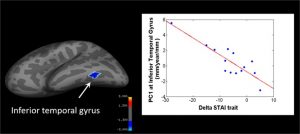Structural and Functional Changes in the Brain Produced by Meditation Training
By John M. de Castro, Ph.D.
“Measurable changes in brain regions associated with memory, sense of self, empathy, and stress start to appear in subjects who practice mindfulness meditation for only eight weeks.” – Deepak Chopra
There has accumulated a large amount of research demonstrating that mindfulness has significant benefits for psychological, physical, and spiritual wellbeing. One way that mindfulness practices may produce these benefits is by altering the brain. The nervous system is a dynamic entity, constantly changing and adapting to the environment. It will change size, activity, and connectivity in response to experience. These changes in the brain are called neuroplasticity. Over the last decade neuroscience has been studying the effects of contemplative practices on the brain and has identified neuroplastic changes in widespread areas. In other words, mindfulness practice appears to mold and change the brain, producing psychological, physical, and spiritual benefits.
Although, these changes have been documented, there is scant evidence regarding the temporal course of the neural changes with increasing experience with meditation. In today’s Research News article “Alterations in Brain Structure and Amplitude of Low-frequency after 8 weeks of Mindfulness Meditation Training in Meditation-Naïve Subjects.” (See summary below or view the full text of the study at: https://www.ncbi.nlm.nih.gov/pmc/articles/PMC6662752/), Yang and colleagues recruited meditation naïve college students and provided them with a 8 week meditation training program. They met for 1.5 hours once a week and were requested to meditate at home for 45 minutes daily. They were measured before and after the meditation program for mindfulness, anxiety, depression, and mood, including anger, fatigue, tension, depression, vigour and friendliness. In addition, their brains were measured with functional Magnetic Resonance Imaging (fMRI) before and after training.
They found that after meditation training there were significant decreases in anxiety and depression and significant increases in the non-reactivity facet of mindfulness. Cortical thickness significantly increased over training in the precuneus and superior parietal lobule while local brain activity fluctuations decreased in the precuneus and inferior parietal lobule. The parietal cortex is associated with bodily sensation and self-referential thinking while the precuneus is associated with the default mode network involved in mind wandering and self-referential thought.
The study did not contain a control condition. So, conclusion must be reached carefully. But the results suggest that mindfulness meditation training decreases anxiety and depression, which has been previously well documented. The neural findings that meditation training resulted in decreased brain activity fluctuations in the precuneus and inferior parietal lobule suggests that the training reduces activity in brain regions associated with mind wandering and self-referential thinking, which have also been well documented previously. Focusing on the present moment as is trained in mindfulness meditation cannot coexist with mind wandering and self-referential thinking. So, it is not surprising that there’s reduced activity in the brain regions underlying these functions.
All of this suggests that mindfulness meditation training changes the brain in ways that reflect greater present moment awareness and less daydreaming and discursive thinking.
“as the popularity of mindfulness grows, brain imaging techniques are revealing that this ancient practice can profoundly change the way different regions of the brain communicate with each other – and therefore how we think – permanently.” – Tom Ireland
CMCS – Center for Mindfulness and Contemplative Studies
This and other Contemplative Studies posts are also available on Google+ https://plus.google.com/106784388191201299496/posts and on Twitter @MindfulResearch
Study Summary
Chuan-Chih Yang, Alfonso Barrós-Loscertales, Meng Li, Daniel Pinazo, Viola Borchardt, César Ávila, Martin Walter. Alterations in Brain Structure and Amplitude of Low-frequency after 8 weeks of Mindfulness Meditation Training in Meditation-Naïve Subjects. Sci Rep. 2019; 9: 10977. Published online 2019 Jul 29. doi: 10.1038/s41598-019-47470-4
Abstract
Increasing neuroimaging evidence suggests that mindfulness meditation expertise is related to different functional and structural configurations of the default mode network (DMN), the salience network (SN) and the executive network at rest. However, longitudinal studies observing resting network plasticity effects in brains of novices who started to practice meditation are scarce and generally related to one dimension, such as structural or functional effects. The purpose of this study was to investigate structural and functional brain network changes (e.g. DMN) after 40 days of mindfulness meditation training in novices and set these in the context of potentially altered depression symptomatology and anxiety. We found overlapping structural and functional effects in precuneus, a posterior DMN region, where cortical thickness increased and low-frequency amplitudes (ALFF) decreased, while decreased ALFF in left precuneus/posterior cingulate cortex correlates with the reduction of (CES-D) depression scores. In conclusion, regional overlapping of structural and functional changes in precuneus may capture different components of the complex changes of mindfulness meditation training.
https://www.ncbi.nlm.nih.gov/pmc/articles/PMC6662752/
